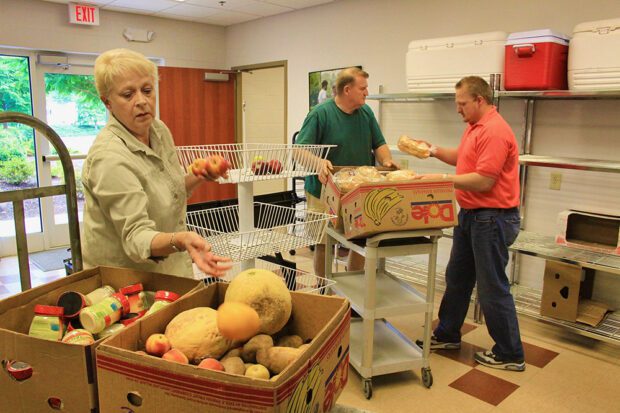
Food insecurity. The phrase is so compact that you might think it has to do with something relatively small.
But the crisis it’s referring to is massive, something that really hit home when Kym Dildine, co-CEO at the Central California Food Bank (CCFB), offered a recent tour of the CCFB’s Fresno facility.
The entrance to the front office is modest, and when you step inside it still seems like a fairly low-key operation. It’s only when you go back into the warehouse area that you realize how vast the site actually is—and, by extension, how urgent the need for food is in our area.
The CCFB (ccfoodbank.org/) is the largest operation of its kind in Central California. The site has 140,000 square feet under roofing. Its refrigerated section, which stores such produce as corn, apples, squash, nectarines, oat milk and peaches, comprises 10,000 square feet.
More than half of what the CCFB provides is fresh fruit and vegetables. Since 2017, it has rescued millions of pounds of food from the landfill. Produce that didn’t meet the standards for retail outlets—for example, onions deemed “too large”—were distributed here.
The CCFB’s staff includes 7,000 volunteers. It presides over a vast network of food assistance, with 500 programs that span several counties. They help to supply 220 member pantries, housed in places such as community centers and churches.
In addition, the CCFB offers an onsite Groceries to Go service. Clients can register for an appointment online and then drive to the site. A staff member will bring out their food allotment on a cart. At present, the program supports a hundred households.
With the help of a state grant, the Fresno site also runs a diaper bank for local families, handing out 600,000 diapers each month. Given the state’s budgetary woes, however, that program is set to expire in September.
The CCFB has been at its location on Amendola Drive since 2018. Substantially larger than its previous site, the new space proved beneficial in meeting the rising needs during the pandemic.
These days, however, as many people are being served as during the onslaught of Covid. The CCFB was serving 340,000–350,000 each month during the pandemic and currently serves that many as well. And that number is rising.
The CCFB management is now making plans to expand their facility. At present, they’re seeking permits from the City of Fresno so that they can proceed.
Even an operation of this scale, though, falls far short of Central California’s food needs. Dildine estimates that food banks are currently meeting 65% of the need for food assistance in the area.
At this point, the CCFB is taking in about 20% less in donations than during the pandemic. The decline has been especially noticeable the past six months.
What sorts of individuals avail themselves of the food bank’s programs? Most of the households that it serves have at least one person working. Lots of college students require food assistance, and all colleges and universities in Central California have food pantries.
On the other hand—and contrary to what many might assume—less than 1% of those served by the CCFB are homeless.
Native Americans suffer most from food insecurity, according to demographic data that the food bank has gathered.
Part of the increase in the need for food assistance has to do with the sharp rise of food prices, Dildine notes.
And what’s happening locally is going on across the country.
Robert Reich, a former U.S. Secretary of Labor, echoes Dildine’s comments about the dire consequences of inflation in one of his recent columns called “A Tale of Two Consumers.”
Reich reports that lower-income consumers receive hourly wages that, when inflation is taken into account, have stayed frozen for years. Lower-income consumers have used up their pandemic savings and are now relying more heavily on credit cards.
According to Reich’s findings, “the average American household now owes $7,951 in credit card debt”—and this at a time when those cards carry an average interest rate of more than 20%.
A recent article by Carla Ventura in the Progressive Populist also discusses the issue.
“Food insecurity fell to a record low of 10.2% in 2021—in the middle of the pandemic—due to the pandemic-era boost in SNAP (Supplemental Nutrition Assistance Program) benefits.” Such support has been eliminated, though, and now almost 13% of our country’s population suffer from food insecurity.
Her plea: The minimum wage needs to be raised. Someone earning that amount can’t afford the average rent for a two-bedroom apartment anywhere in the country.
Despite these striking figures, the food crisis has been under the radar for many people. During this election year, for example, it’s rarely present in candidates’ stump speeches or position statements.
That became evident during the CNN debate between Joe Biden and Donald Trump in late June. At no time in that encounter did either candidate mention food insecurity, and neither of the moderators raised the issue. At that time, the official Trump and Biden campaign websites revealed the same glaring absence.
Dildine argues that this is a problem that can be solved. After all, we as a country have the resources at our disposal so that it can happen.
Political realities will make it an arduous uphill struggle, though.
SNAP “reduces hunger by about 30%,” Ventura points out, and more than 44 million people in the United States currently depend on it.
Still, some legislators in Congress have proposed slashing the program by $30 billion over the coming decade.
